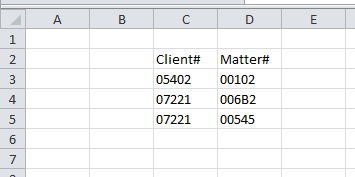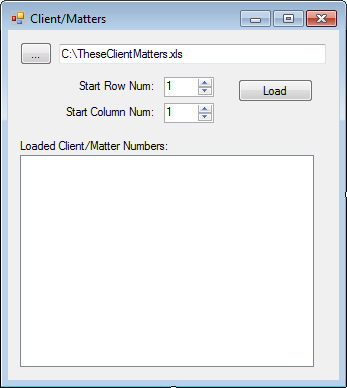I have an application that loads a list of client/matter numbers from an input file and displays them in a UI. These numbers are simple zero-padded numerical strings, like "02240/00106". Here is the ClientMatter class:
public class ClientMatter
{
public string ClientNumber { get; set; }
public string MatterNumber { get; set; }
}
I'm using MVVM, and it uses dependency injection with the composition root contained in the UI. There is an IMatterListLoader service interface where implementations represent mechanisms for loading the lists from different file types. For simplicity, let's say that only one implementation is used with the application, i.e. the application doesn't support more than one file type at present.
public interface IMatterListLoader
{
IReadOnlyCollection<string> MatterListFileExtensions { get; }
IReadOnlyCollection<ClientMatter> Load(FileInfo fromFile);
}
Let's say in my initial version, I've chosen an MS Excel implementation to load the list of matters, like this:
I'd like to allow the user to configure at runtime the row and column numbers where the list starts, so the view might look like this:
And here's the MS Excel implementation of IMatterListLoader:
public sealed class ExcelMatterListLoader : IMatterListLoader
{
public uint StartRowNum { get; set; }
public uint StartColNum { get; set; }
public IReadOnlyCollection<string> MatterListFileExtensions { get; set; }
public IReadOnlyCollection<ClientMatter> Load(FileInfo fromFile)
{
// load using StartRowNum and StartColNum
}
}
The row and column numbers are an implementation detail specific to MS Excel implementations, and the view model doesn't know about it. Nevertheless, MVVM dictates that I control view properties in the view model, so if I were to do that, it would be like this:
public sealed class MainViewModel
{
public string InputFilePath { get; set; }
// These two properties really don't belong
// here because they're implementation details
// specific to an MS Excel implementation of IMatterListLoader.
public uint StartRowNum { get; set; }
public uint StartColNum { get; set; }
public ICommandExecutor LoadClientMatterListCommand { get; }
public MainViewModel(IMatterListLoader matterListLoader)
{
// blah blah
}
}
Just for comparison, here's an ASCII text file based implementation that I might consider for the next version of the application:
public sealed class TextFileMatterListLoader : IMatterListLoader
{
public bool HasHeaderLine { get; set; }
public IReadOnlyCollection<string> MatterListFileExtensions { get; set; }
public IReadOnlyCollection<ClientMatter> Load(FileInfo fromFile)
{
// load tab-delimited client/matters from each line
// optionally skipping the header line.
}
}
Now I don't have the row and column numbers that the MS Excel implementation needed, but I have a Boolean flag indicating whether the client/matter numbers start on the first row (i.e. no header row) or start on the second row (i.e. with a header row).
I believe the view model should be unaware of the change between implementations of IMatterListLoader. How do I let the view model do its job controlling presentation concerns, but still keep certain implementation details unknown to it?
Here's the dependency diagram:





IMatterListLoaderhas such a notion as "rows" and "columns". Another implementation might not have that; it might be an ASCII text file with comma-delimited list on a single line, for example. In such a case, there's no notion of columns and rows so the configuration available to the user would be completely different. The VM wouldn't (shouldn't) change at all though. – Roughhouse